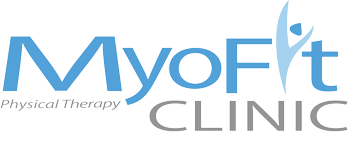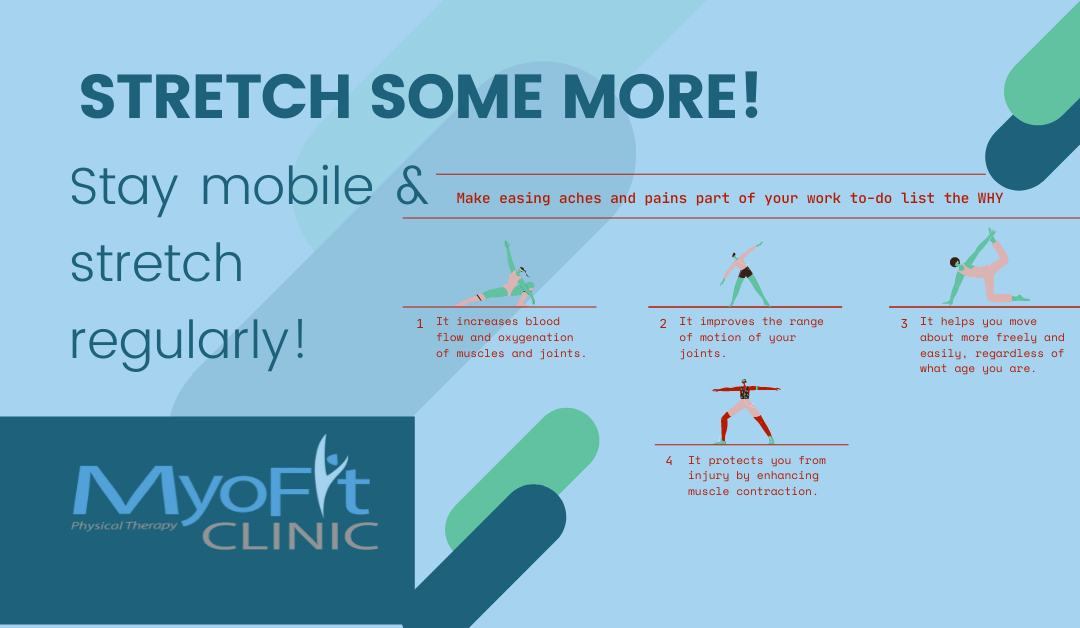By Dr. Adam M. Cramer, PT, DPT
One of the simplest, most effective things you can do to keep your body in good working order and stay mobile as the years pass is to stretch regularly.
When I talk to my physical therapy patients about this, they are always a little taken aback. They think I am going to tell them to run marathons or take up weight-lifting or make some enormous commitment. All I ask is for them to make time at least twice a week to stretch each of their major muscle groups. If pain is present around a joint or muscle group prior to stretching, stretching is the key to reduce the symptoms.
The American College of Sports Medicine tells people the same thing, and to ensure that they spend at least 60 seconds on each stretching exercise.
I’m a keen proponent of stretching because of all the good things it does for your body.
For example:
-It increases blood flow and oxygenation of muscles and joints.
-It improves the range of motion of your joints.
-It helps you move about more freely and easily, regardless of what age you are.
-It protects you from injury by enhancing muscle contraction.
For all of these benefits, there is no major effort. It is a gentle and slow exercise. You don’t have to gasp for breath. You don’t sweat profusely. You definitely shouldn’t feel any pain although you should feel the stretch itself it will be uncomfortable initially when you start stretching. You don’t have to buy any special equipment or even a fancy gym outfit.
You can do it anytime, either after more vigorous exercise, or just all on its own.
Additional benefits extended into lifestyle Stretching is a natural stress reliever as well and encourages you to think more positively. When you are stressed, think about how your muscles contract, adding to your tenseness. When you stretch, you release this pent-up stress in your body, and in turn, your mind feels less burdened. It relaxes your muscles and encourages your blood to flow easily through your body.
Some patients tell me anecdotally that by standing and going through their stretching routines each morning and afternoon of their workdays, they feel refreshed and re-energized when they return to their tasks. Others who previously had trouble sleeping reported that a pre-bedtime stretching session prompted a better, deeper sleep. That may be linked to its release of endorphins, the feel-good hormone.
Stretching also firms up your posture and increases your stamina as the blood flows to your extremities. In fact, it promotes better blood circulation and this is good for your health overall.
Specific health benefits researched
The health benefits I have already mentioned have been well chronicled for some time, but there are other good effects that we have only gotten to know about in the last few years as more and more research has accumulated on the impact of stretching on the body.
For example, a 2007 study1 published in the Archives of Internal Medicine revealed that women with fibromyalgia may experience significantly improved daily function and fewer symptoms after taking part in a stretching program that also included walking and strength training.
This was fascinating to me because like most physical therapists, I see a number of patients suffering from this condition which causes them to experience debilitating chronic pain throughout their bodies.
Meanwhile, a 2015 study2 published in Health Technology Assessment found that simple stretches and strengthening exercises can help alleviate symptoms of rheumatoid arthritis (RA) in the hands and wrists.
The authors concluded based on their research that stretches can support conventional methods of care for this condition.
Some stretching caveats
For patients who live sedentary lives, I encourage them to get up and move around a little bit before they start to stretch their bodies. Just walk from room to room or do a couple of simple chores so that you are not moving from total inertia into stretching.
A lot of people find stretching uncomfortable because they forget to breathe. It is okay to feel your breath going in and out of your body as you stretch.
It is a good idea to visit your physical therapist before embarking on a stretching program. Doing it right, and gearing your specific stretches to accommodate the specific needs of your body and level of mobility is important.
What you don’t want to do is simply get an idea that you should start stretching, start into it without any in-depth knowledge of what your body needs or doesn’t need, and then risk injury and more pain as a result.
Good strategies to get started
If you want to see some examples of the different kinds of stretches available and how they impact different parts of your body, I recommend that you visit the Mayo Clinic website and view their slide show: “A Guide to Basic Stretches.”
You can access it here: Guide to basic stretching
Schedule an appointment to consult with a Doctor of physical therapy and ask for an assessment and then a prescribed program of stretches. This will ensure that what you start with is safe and designed specifically for your body. Doing it right, and gearing your specific stretches to accommodate the specific needs of your body and level of mobility is important.
Dr. Adam M. Cramer, PT, DPT, is a licensed physical therapist, stretching specialist, and owner of MyoFit Clinic in Chardon, Ashtabula, and Middlefield, Ohio. 440.286.1007 or 440.632.1007
References:
Rooks DS, Gautam S, Romeling M, et al. Group Exercise, Education, and Combination Self-management in Women With Fibromyalgia: A Randomized Trial. Arch Intern Med. 2007;167(20):2192–2200. https://jamanetwork.com/journals/jamainternalmedicine/fullarticle/413399
Williams MA, Williamson EM, Heine PJ, et al.; on behalf of the SARAH trial group. Strengthening and stretching for Rheumatoid Arthritis of the Hand (SARAH). A randomized controlled trial and economic evaluation. Southampton (UK): NIHR Journals Library; 2015 Mar. (Health Technology Assessment, No. 19.19.)Available from: https://www.ncbi.nlm.nih.gov/books/NBK279710/ doi: 10.3310/hta19190

